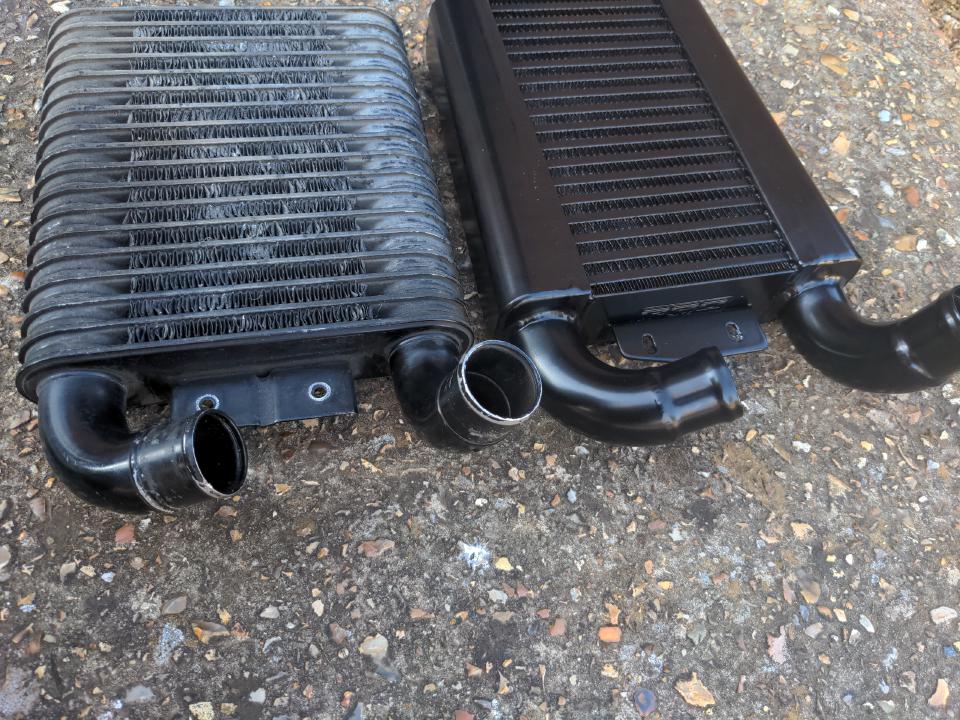Rationalising the 323 GTX, part 1: the intercooler
This is my 323 GTX's new intercooler, next to its original one. The new one is a work of art with a 60mm core made by Pro Alloy. The original one is old, weird and inefficient.
So, the Mazda 323 GTX is not dead or abandoned. I put it in warm dry storage, because if I had to look at it every day after the engine's near-death experience I probably would have stripped it and scrapped it. I intended to get back to the Mazda after the P5 was done, because I thought I would have the P5 done within a year.
The GTX came out of storage a while back, and is currently having its engine rebuilt. Someone else is doing that for me, but this has also given me the opportunity to rationalise some things around the intake side of the engine. Some of it is merely old. Some of it has been badly modified over the years, and needs re-modifying in less bad ways. I would never get around to doing all of this if i was still using the car, so maybe the engine death was an expensive blessing in disguise. I have called this "rationalisation" in the title of the post, as if there was anything rational about owning a 1980s rally car that you can't get any parts for.
One of those things is the intercooler. It is in the "merely old" category. It used to fit like this in the car:
The 323 GTX's intercooler is an old, bad design. This can be forgiven, because this was 1987, and to my dismay 1987 was 36 years ago. It likely did not do very much, but it didn't do very much just as well as anything else of its era. The bent fins that came with age and from being mishandled means it probably did even less. With my newfound desire for reliability, I wanted to replace it with something a bit better.
A recurring problem of owning old, weird, near-extinct cars is that there is a wealth of information out there, from forum posts written 15 years ago. Someone would have solved a known limitation of your car by finding a simple bolt on upgrade from a car that was common at the time and is now just as extinct as your car is. In the case of the 323 GTX, it was an easy bolt-on upgrade to its intercooler with a bigger, much better-designed one from...a first-generation Ford Probe or Mazda MX-6. Well then!
(Digressing, my favourite in that genre was trying to find seats for my mum's Suzuki SJ 410. All you needed to do was pull the seats out of a Suzuki Swift GTi! They bolt right in!)
The obvious solution would have been to go with a big front-mount intercooler. I did not relish the possibility of chopping anything up to mount one (like the unobtainable-at-any-price front bumper). Neither did I want the hassle of reworking all the pipework. I'm going to have to do some reworking of it anyway, because of a different turbo (more about this soon), but a completely different configuration is effort.
I don't know that there would be other complications I cannot foresee with an FMIC setup, because I cannot think of any. I also do not know that there will not be any complications because I cannot think of any.
What I wanted was a modern, efficient intercooler which fit in the same space as the existing one. This did not exist, until Pro Alloy made one for me.
The new intercooler is spectacular. It is a much better design, and the quality of the work is impeccable. It came with a price tag that would seem expensive, if you did not price in the fact that I was paying professionals to design something that didn't exist before and then hand-make that thing to the highest standard.
It has been designed to fit in the same space as the original intercooler, using the same mounting points. The pipes are of the same size, and come out in the same place. The height and width of the intercooler does not exceed that of the original at any point. It is somewhat thicker, but the cunning part is that this thickness has been engineered to extend into the engine side, where there is room, rather than into the front panel, where there is none.
It looks right to me; OEM, or maybe OEM+. It should give me more reliable power. It might even sound a bit nicer, too.
...or it will just act as a much more efficient engine-to-intake-air heat exchanger! We'll find out when all of this goes back together. Onwards!




